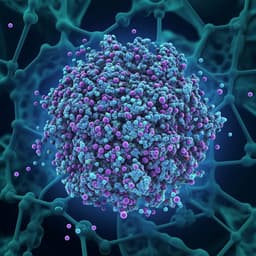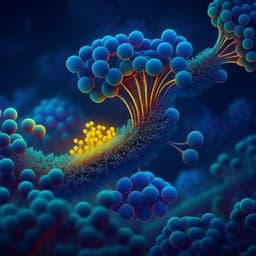![Ag₃PO₄ enables the generation of long-lived radical cations for visible light-driven [2+2] and [4+2] pericyclic reactions](/_next/image?url=https%3A%2F%2Fd11tyujt19m6rg.cloudfront.net%2Fthumbnails%2Fmedium%2F595baea4ac4a1e4efa064e8fd092ea8fdc31cafa0914817d072799f8f0ed1f4626ccdc259ba1.jpg&w=640&q=75)
Chemistry
Ag₃PO₄ enables the generation of long-lived radical cations for visible light-driven [2+2] and [4+2] pericyclic reactions
L. Guo, R. Chu, et al.
Discover how Ag₃PO₄ acts as a remarkable catalyst for both intramolecular and intermolecular [2+2] and Diels-Alder cycloadditions, utilizing visible-light irradiation. This groundbreaking research by Lirong Guo and colleagues presents an innovative, additive-free method that generates long-lived radical cations, showcasing the potential of inorganic semiconductors for radical cation-mediated synthesis powered by sunlight.
~3 min • Beginner • English
Introduction
The study addresses the challenge of generating and utilizing aromatic alkene radical cations for pericyclic bond-forming reactions under mild, sustainable conditions. While homogeneous photocatalysts (transition metal complexes and π-conjugated organics) can oxidize alkenes, the short microsecond-scale lifetime of radical cations limits efficiency and scope. Inorganic semiconductor photocatalysts are attractive for scalability and robustness but typically show poor one-electron oxidation of nonpolar C=C bonds due to ultrashort hole lifetimes and rapid back-electron transfer, leading to low quantum yields and over-reduction/side reactions. Ag₃PO₄ is proposed as a visible-light-responsive inorganic photocatalyst with strong oxidizing holes (+2.9 V vs NHE), weakly reducing conduction band electrons (+0.45 V vs NHE), and PO₄³⁻-rich surfaces that can strongly interact with cationic intermediates. The hypothesis is that Ag₃PO₄ can both generate and stabilize long-lived alkene radical cations on its surface, enabling efficient [2+2] and [4+2] photocycloadditions under visible light.
Literature Review
Prior work has demonstrated radical cation-mediated [2+2] and Diels–Alder cycloadditions using homogeneous photoredox catalysts (e.g., Ru complexes, organic dyes), strong single-electron oxidants (Ce⁴⁺, Fe³⁺, hypervalent iodine), and some heterogeneous systems (TiO₂, g-C₃N₄, quantum dots). However, the lifetime of styrene-type radical cations in solution is typically on the order of microseconds, hampering bimolecular coupling before back-electron transfer. Heterogeneous TiO₂ often requires UV light, excess catalyst, salts to stabilize radical cations, and still suffers from electron accumulation and low conversions. Ag₃PO₄ has been widely applied in visible-light water oxidation and pollutant degradation, with reports of strong hole oxidation power and inherent visible response, but its use in radical cation pericyclic synthesis and lifetime extension of such intermediates had not been established. The present work builds on these findings by exploiting Ag₃PO₄’s band positions and surface electrostatics to stabilize radical cations and improve photocatalytic pericyclic reaction outcomes.
Methodology
- Photocatalyst: Ag₃PO₄ nanospheres (self-synthesized; ~230 ± 60 nm) and various faceted Ag₃PO₄ crystals; commercial samples also tested. Catalyst loadings typically 0.05–0.20 equiv relative to limiting substrate.
- Light sources: 425 nm LED for laboratory reactions; natural sunlight (15–23 mW cm⁻², 1–10 °C ambient) for scale-up. Ag₃PO₄ harvests visible light up to ~500 nm; AQY action spectrum measured from initial 30 min yields.
- General conditions: Reactions conducted in HFIP solvent under N₂ (99.999%), 0 °C, after 30 min dark equilibration to establish adsorption–desorption equilibrium. No additives used. Reaction progress monitored by TLC; products isolated by column chromatography.
- Model [2+2] homo-dimerization: Anethole (1a, 1.0 mmol), Ag₃PO₄ (27 mg, 0.12 equiv), HFIP (3.0 mL), 425 nm LED, N₂, 0 °C, 12 h.
- Crossed [2+2]: Counterpart alkene 3 (1.0 mmol, 2.0 equiv) in HFIP (2.0 mL) with Ag₃PO₄ (44 mg, 0.20 equiv); after degassing and equilibration, a solution of 1a (0.5 mmol in 2.0 mL HFIP) was syringe-pumped at 4.0 mL h⁻¹ during irradiation to suppress homo-dimerization.
- Intramolecular [2+2]: Bis(styrene) substrate 5 (0.3 mmol) in HFIP (2.0 mL), Ag₃PO₄ (12 mg, 0.10 equiv), standard irradiation protocol.
- Diels–Alder [4+2]: Diene 7 (2.0 mmol) in HFIP (2.0 mL) with Ag₃PO₄ (32 mg, 0.08 equiv); degas/equilibrate, then add aromatic alkene 1 (1.0 mmol in 2.0 mL HFIP) via syringe pump at 4.0 mL h⁻¹ during irradiation.
- Controls and comparisons: Dark or no-catalyst controls (no reaction). Air atmosphere gave oxidative products. Solvent screening (HFIP, TFE, MeNO₂, CH₃CN, CH₂Cl₂, EtOAc, THF, n-hexane). Comparison with other Ag salts (AgCl, AgBr, AgI) and with g-C₃N₄, Bi₂MoO₆, TiO₂ (UV and visible).
- Reuse and regeneration: Ag₃PO₄ reused for ≥5 cycles with slight efficiency loss (TON ≈ 13 at 0.12 equiv). Photocorrosion to Ag nanoparticles observed; regeneration by brief immersion in 6.7 mM Na₂HPO₄(aq) with a drop of 30% H₂O₂ restored activity.
- Spectroscopy and kinetics: UV–vis diffuse reflectance and AQY action spectrum. Laser flash photolysis (355 nm, transmission mode) of 1a/Ag₃PO₄/HFIP suspensions to detect transient 1a•+ (peaks at ~387 and 605 nm) and measure decay kinetics. Light on–off experiments to probe post-irradiation reactivity.
- Adsorption/kinetics analysis: Adsorption isotherms of 1a and 2a on Ag₃PO₄; Langmuir fits to obtain KL and Γm. Correlated AQY with fractional surface coverage θ (AQY ∝ θ²) across concentrations, solvents, and facets, consistent with Langmuir–Hinshelwood bimolecular surface mechanism.
- DFT simulations: Modeled adsorption configurations and energies of 1a and 2a on PO₄-terminated and Ag-terminated Ag₃PO₄(100) facets; Bader charge analysis to assess charge transfer and polarization upon adsorption. Considered facet-dependent interactions and hole localization on PO₄ O atoms.
Key Findings
- Ag₃PO₄ is an efficient visible-light photocatalyst for radical cation-mediated pericyclic reactions: intramolecular and intermolecular [2+2] cycloadditions and Diels–Alder [4+2] reactions proceed under additive-free, mild conditions with catalyst recyclability.
- Model [2+2] (anethole 1a → anti-2a): 82% yield after 12 h with d.r. >19:1 under 425 nm LED; equilibrium between 1a and 2a limits further conversion. AQY action spectrum matches Ag₃PO₄ absorption (up to ~500 nm). Under air, 1a is over-oxidized to 4-methoxybenzaldehyde (82% yield), with only 13% 2a.
- Scope: Homo [2+2] of various electron-rich styrenes gave 42–83% yields with d.r. >19:1. Crossed [2+2] with diverse EDG/EWG substituted alkenes afforded high yields and head-to-head regioselectivity; homo-dimer is the only byproduct and minimized by syringe addition. Intramolecular [2+2] (6a–6t) provided good to excellent yields with broad functional group tolerance. Diels–Alder reactions (8a–8h) achieved near-quantitative yields even at 0.08 equiv catalyst; products 8b, 8c, 8d, 8f, 8h isolated with high regioselectivity.
- Diastereoselectivity trends: Intermolecular [2+2] products are nearly all anti; intramolecular [2+2] predominantly syn; Diels–Alder products mostly anti.
- Scalability: Sunlight-driven synthesis delivered 41.5 g of 8a almost quantitatively in 6 h in one pot. Large-scale homo [2+2] of 1a reached 60% before catalyst deactivation at 0.05 equiv; after catalyst regeneration, final yield reached 80%.
- Catalyst stability and regeneration: 0.12 equiv Ag₃PO₄ sustained five cycles with slight loss (TON ≈ 13). Photocorrosion to Ag nanoparticles occurs; simple Na₂HPO₄/H₂O₂ treatment restores color, morphology, and performance.
- Comparisons: Ag₃PO₄ outperforms AgCl, AgBr, AgI (which rapidly decompose) and common heterogeneous PCs (g-C₃N₄, Bi₂MoO₆, TiO₂). TiO₂ shows low rate and electron accumulation (blue color), stalling at ~18% conversion; under air, TiO₂ gives mainly aldehyde (67%) and <10% 2a.
- Mechanistic evidence: LFP detected 1a•+ on Ag₃PO₄/HFIP with peaks at ~387 and 605 nm; lifetime exceeds 1.9 ms in suspension, far longer than ~25 µs in homogeneous solution. Light-off experiments show continued product growth (~+8% over 6 h when stirred), ceasing when Ag₃PO₄ settles, indicating surface-confined long-lived 1a•+.
- Surface kinetics and adsorption: 1a adsorption on Ag₃PO₄ follows Langmuir isotherm with KL = 5.8 ± 0.6 M⁻¹ and Γm = 2.9 ± 0.1 mmol g⁻¹; 2a adsorption is weak. AQY scales with θ² across concentrations, solvents, and facets, consistent with a Langmuir–Hinshelwood bimolecular RLS involving two adsorbed 1a molecules.
- DFT insights: Strong adsorption of 1a on PO₄-terminated (100) along a-axis (Eads = −2.10 eV); 2a adsorption weaker (−1.56 eV). Two 1a vs one 2a adsorption energy difference of +2.64 eV favors product desorption. Bader analysis shows 0.34e transfer from 1a to surface and polarization, activating the C=C for oxidation; holes localized at PO₄ O facilitate 1e− oxidation.
- Band structure role: Valence band holes are strongly oxidizing (EVB ≈ +2.90 V vs NHE) to generate radical cations; conduction band electrons are weakly reducing (ECB ≈ +0.45 V vs NHE) and delocalize over Ag lattice, lowering recombination and stabilizing surface radical cations (>2 ms lifetime).
Discussion
The work demonstrates that Ag₃PO₄ addresses the core limitation in radical cation photochemistry—the fleeting lifetime of intermediates—by leveraging a favorable band structure and strong electrostatic stabilization at PO₄³⁻-rich surfaces. Photogenerated holes efficiently oxidize adsorbed alkenes to radical cations, while delocalized, weakly reducing conduction band electrons minimize rapid back-electron transfer. As a result, radical cations persist for milliseconds, enabling the bimolecular, surface-confined rate-limiting step (1a•+ + 1a → 2a•+) to proceed with high efficiency. The observed AQY ∝ θ² relationship across conditions validates a Langmuir–Hinshelwood mechanism and underscores the importance of substrate adsorption and surface coverage. Facet and solvent effects modulate adsorption and thus rates; DFT corroborates stronger adsorption of reactants than products and activation of the C=C bond upon adsorption. Compared with TiO₂ and other heterogeneous PCs, Ag₃PO₄ provides visible-light activity, higher selectivity, and additive-free operation, translating into broad substrate scope, high diastereoselectivity, and scalability under sunlight. These findings expand the utility of inorganic semiconductors for sophisticated radical cation-mediated pericyclic syntheses.
Conclusion
Ag₃PO₄ is established as a robust, recyclable, visible-light photocatalyst for additive-free radical cation-mediated [2+2] and Diels–Alder [4+2] cycloadditions. Key advances include demonstrating millisecond-lived alkene radical cations on Ag₃PO₄ surfaces, validating a surface Langmuir–Hinshelwood bimolecular RLS, and achieving broad, diastereoselective scope with near-quantitative yields in some cases. The system scales effectively under natural sunlight and allows facile catalyst regeneration. By revealing how band structure and surface electrostatics prolong radical cation lifetimes and suppress recombination, this study paves the way for applying inorganic semiconductors to other challenging radical cation and potentially radical anion transformations. Future work could optimize facet engineering, broaden substrate classes (including more electron-poor alkenes), integrate continuous-flow photochemistry, and generalize the stabilization strategy to other semiconductors.
Limitations
- The [2+2] cycloadditions require an inert atmosphere; under air, over-oxidation to aromatic aldehydes dominates.
- Certain substrates (e.g., NO₂-, OH-, COOH-substituted aromatic alkenes) are challenging and show poor reactivity.
- Photocorrosion of Ag₃PO₄ occurs over cycles (Ag nanoparticle formation), necessitating periodic regeneration with Na₂HPO₄/H₂O₂.
- Reaction performance is highly solvent-dependent and optimal in HFIP; in other solvents activity can be low.
- Equilibrium between starting material and product (e.g., 1a/2a) can cap yields (~82% for 2a) despite longer irradiation.
- Catalyst deactivation observed at low loadings in large-scale runs, requiring re-addition or regeneration to reach target yields.
- The demonstrated scope focuses on aromatic, relatively electron-rich alkenes; extension to more electron-deficient or aliphatic systems may require further optimization.
Related Publications
Explore these studies to deepen your understanding of the subject.







